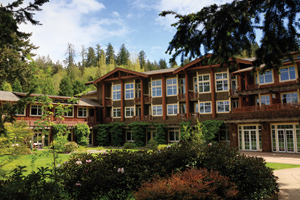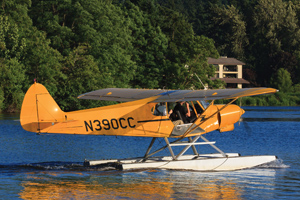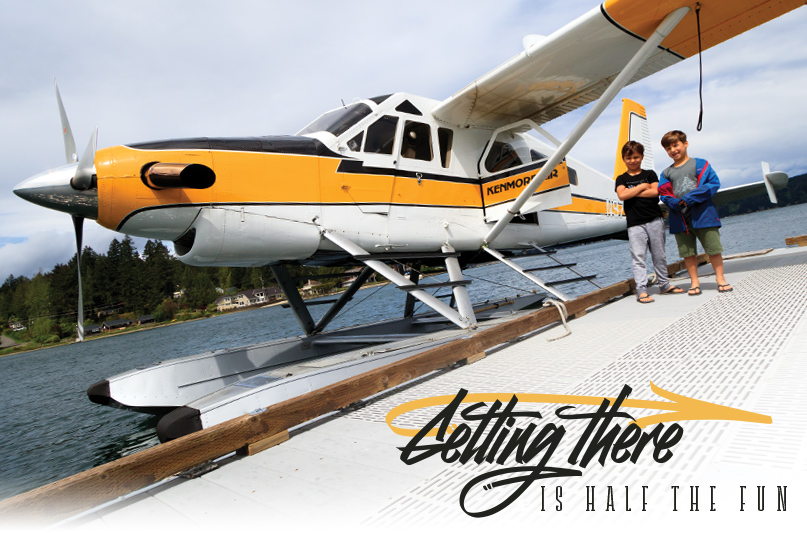
 It’s a cloudy, blustery morning on the Hood Canal and all is quiet on the docks at the Alderbrook Resort in Union, Washinton. The rain has cleared up, but the wind and currents are strong, only the cormorants and a lone aluminum fishing boat brave the water this morning.
It’s a cloudy, blustery morning on the Hood Canal and all is quiet on the docks at the Alderbrook Resort in Union, Washinton. The rain has cleared up, but the wind and currents are strong, only the cormorants and a lone aluminum fishing boat brave the water this morning.
On the eastern horizon, a tiny black object appears above the trees, moving in fast and against the wind — it’s a de Havilland Canada Turbo Beaver. The Kenmore Air seaplane descends slowly, just touching the surface with a single pontoon then putting down both, gliding through the spray for a smooth landing as the pilot reverses thrust to slow the aircraft in the water.
Two minutes later, the Turbo Beaver is at the dock, and passengers — six Redmond software engineers on a corporate outing — are exiting for an afternoon of fun. They’ve been in the air only 19 minutes — the Turbo Beaver can transport people in quiet comfort at 140 miles per hour, and if the weather is cooperative, it can go almost anywhere with a long enough stretch of water for landing and takeoff, including sheltered anchorages far from civilization. A big part of Kenmore Air’s charter business is transporting boaters directly to and from individual boats and marinas during cruising season.
Pilot Steve Bjorling, an 18-year veteran of Kenmore Air, ties up the plane and gets ready to wait with the aircraft for a couple of hours. “Sometimes, I’m turning right around to go back, but today is relatively slow,” he says. As he gets ready for the wait, two young boys and their father come up to pose with the plane. During the three hours the Beaver is docked, over half a dozen people will take selfies with it.

“It’s my favorite of our fleet to fly,” says Bjorling. The Turbo Beaver is an enlarged version of Kenmore Air’s mainstay, the six-passenger de Havilland Canada DHC-2 Beaver, but where the Beaver has a 450-horsepower Pratt & Whitney R-985 Wasp Junior radial engine, the seven-passenger Turbo enjoys 680 horses from a Pratt & Whitney PT6A-34 Turboprop. It is the Boss Mustang to the DHC-2 Beaver’s Ford Falcon.
But first-time flyers will be surprised that even though they feel fast and glamorous as the float plane accelerates on the water, the flying experience of the airplanes is not one of raw speed but of genteel comfort. Kenmore’s planes typically fly at about 1,500-2,000 feet — high enough to get a great view of the Northwest scenery as outside the large window, but not so low as to discern the actual ground speed.
Passengers wear headsets to talk to each other and the pilot, and the seats feel more like those in a vintage sports car than an airliner — but comfier. “It’s a more relaxed way to travel,” says Bjorling. “When people get on a regular flight [on a jet], they’re sort of enduring that experience, not enjoying it. This is something fun.”
There’ll be plenty of people enjoying as the summer arrives; the airline transports more than 85,000 customers a year, and demand is highest in the summer as flyers head to points north such as lodges, resorts, and boats.
During the high season when cruisers and tourists head north to spend their days kayaking and their nights eating fresh-caught fish at resorts, Kenmore serves 42 scheduled seaplane destinations (seven are served year-round) from its two home bases — Seattle’s Lake Union and Kenmore Air Harbor at the top of Lake Washington. A quarter of these popular scheduled stops are in the San Juan Islands, only 35 to 45 minutes from Seattle. The rest are in British Columbia, stretching all the way up to Sullivan Bay — a nearly three-hour flight.
Scheduled stops are generally set at the most popular lodges and largest destinations, like Sonora Resort in British Columbia or Rosario Resort in the San Juans, but some are also geared to popular anchorages like Prideaux Haven, where many cruising boaters congregate. Aside from those in the San Juans or on Vancouver Island proper, many of these destinations are accessible only by water, making float planes the only option for getting there quickly.
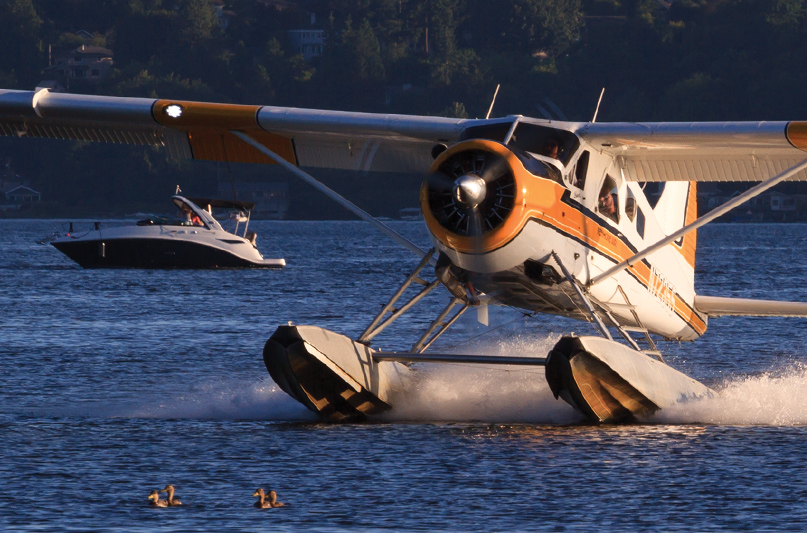
making them a unique resource for cruising boaters.
A scheduled Kenmore Air trip to Prideaux Haven runs $660 round trip per person, and for most customers this is a perfect choice. Anybody headed to Prideaux Haven should be aware that there isn’t a dock there. Passengers exit onto dinghies and skiffs that belong to whomever they’re joining — and it’s the passenger’s responsibility to arrange for pickup.
New customers who might be more used to flying on 747s might also want to pack light. Kenmore’s aircraft are fairly capacious, but scheduled service passengers are limited to bringing along only 25 pounds of luggage each. Bringing only what you need can be an adventure too.
If the destination you want isn’t on the schedule or if it’s the off-season, there’s still a way to get there — like the Redmond software engineers did — by chartering.
In addition to the 42 scheduled destinations, Kenmore has 500+ specific float plane charter destinations. These are distinct points of interest that visitors frequent, but perhaps without sufficient demand for a scheduled stop. But chartering means more than going off the beaten path — it’s about being able to go anywhere, anytime.
“People charter for all kinds of reasons,” says Kenmore’s Charter & Group Sales Manager Emily Mamales, “Some people just want their own aircraft. They know they might be bringing more than 25 pounds, they might be bringing supplies for the boat or even doing a crew change.”
Mamales, a boater herself with a 42-foot Grand Banks named Patience, is very familiar with the needs of the boating community and those who cruise with guests. “For some people, they’ll go up with a group and then return with another as they’re changing guests,” noting that the boating community is a significant portion of the charter market.
Significantly, there’s no cargo limit beyond the capacity of the aircraft itself. That can help with resupplying a large boat or flying in a spare part. Instead of 25 pounds per person, Mamales says, “you have the full capacity of our aircraft allowed to you, whether you fill it with passengers or gear.” Mamales advises making sure that gear is appropriate to your journey because you’ll have to declare it at customs.
Charters can come and go on the customer’s schedule, and the planes can go almost anywhere a customer wants, although that can require careful planning.
“If I’ve got somebody up in the Broughton Islands that needs to get home in an emergency or unusual situation, we take a look at their location,” Mamales says, “and whether or not there’s a sufficient landing location that we can either meet a boat and have them take a skiff over, or if there’s a nearby marina that we’ve used before that we know is seaplane friendly.”
“Taking a look” might involve getting pictures of the terrain from the potential charter client and some careful study of the surrounding area. For this, Mamales often turns to the same tools as cruisers. “I have my Waggoner’s Cruiser Guide at my desk and I’m constantly looking to verify locations,” she says.
The planes can also float up to beaches if the conditions are right. Back at Alderbrook, the two boys admiring Pilot Steve’s Turbo Beaver notice that there are two wooden oars strapped to the insides of the pontoons and inquire about them.
“Those are for pushing off and away from beaches,” Bjorling answers. “But they don’t get used much, they usually just age until we replace them.” But the oars are there if needed.
All this comes at a cost, of course. Reserving your own aircraft is a premium service. A scheduled service trip to Refuge Cove for four might run $1,288 one way, but they’ll be limited to the 25-pound luggage capacity and the timetable. A charter to the same location would allow the quartet to fill the aircraft and come and go as they please for about $3,100. Prices vary considerably depending on the destination and the aircraft, the more capacious, the higher the cost.
During the busiest times of the summer, charters can’t always wait, mainly because all aircraft are in use. But the airline does its best to help. “They’re very can-do,” says Bob Hutnik. Bob and his wife Nancy, both now retired, spend their summers cruising on Trading Places, their 53-foot Tollycraft.
“Some years ago when I was still working,” says Bob, “Nancy and my son Kyle were up at Seattle Yacht Club’s outstation at Henry Island. They have a big Fourth of July party at the station, but we weren’t going to that party so we had to be off the dock, but I wasn’t there [to drive the boat].”
“I got hung up down in Seattle. On a Friday. On Fourth of July weekend,” adds Bob. “I’m running late, so I call them up, and the dispatcher says, ‘Well, we can’t hold the plane but we have six planes going up, we’ll make your plane the last plane.’”
Despite arriving a few minutes late, Bob made it to Henry Island, crisis averted.
In the family, it’s Kyle who travels the most by seaplane. “They’re in the islands or up north all summer,” Kyle says. “So we’ll coordinate and I’ll take Kenmore up to meet them. I’ve flown into Cortes Bay quite a bit, I’ve flown into Ganges, this year I’m flying into Sullivan Bay and then back out of Dent Island.”
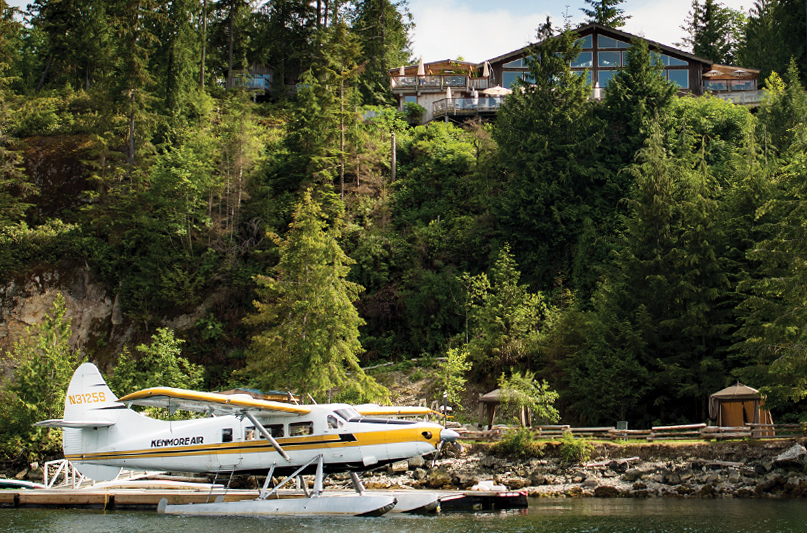
The family does fly together, however, sometimes without the boat as a destination. “We’ve done some fishing trips where we take a four-day weekend at Dent,” says Bob, who smiles at the hidden gem he discovered one day where he caught a fish a few hours before departure.
“The best part is, you can take your fresh-caught salmon, they can put it in a plastic bag and fill it with ice, and they put it in a special compartment in the pontoon. We caught a fish at about 1100 hours and it was on the grill at 1700 hours back at our place in Seattle,” he adds. “It doesn’t get fresher than that.”
The Hutniks have also flown in less than ideal conditions.
“Once,” relates Nancy, “We had a really low-cloud deck. Two planes went out and tried to fly their normal route but turned around and came back. We were heading up to the San Juans and we ended up going up the inside of Whidbey Island and actually flew the Swinomish Channel, and came out by Anacortes, but we were quite low over the water. The view was very interesting.”
Two-and-a-half hours after the software engineers arrived at the quiet oasis of Alderbrook, they head out to the dock where a few recreational fishing boats have gathered for the start of spot shrimp season the next day on the Hood Canal. The Sunshine Coast, Desolation Sound, and the Inside Passage are the most popular fishing destinations for Kenmore passengers, but it’s easy to imagine flying in a friend for one of those four days a year spot shrimp harvesting is allowed.
That’s not how the rest of the day will be spent for the engineers, who pose for selfies and group photos with the Turbo Beaver before clambering back onboard as Bjorling does his preflight checks. Nobody’s eager to bid farewell to the resort, but obligations beckon.
The propeller swiftly spins as the turboprop fires to life, and within a few seconds the aircraft slowly taxis out onto the canal. Bjorling heads out more than a half mile into the water to keep a safe distance from the shore before turning around to takeoff into the eastbound wind.
Bjorling punches the throttle and the buzz of the engine can be heard a half mile away as the plane moves forward, leaving a spray of water in its wake — in just seconds it’s off the water and climbing, banking starboard to make the eastbound trek back to Seattle. In 20 minutes, all aboard will be back in Seattle, but they won’t forget the experience.
